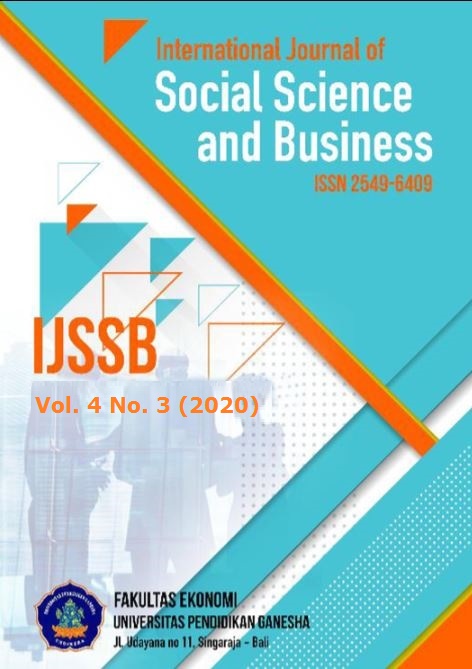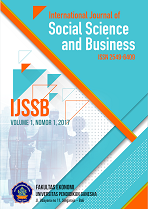The Significance of Accounts Receivable Turnover, Debt to Equity Ratio, Current Ratio to The Probability of Manufacturing Companies
DOI:
https://doi.org/10.23887/ijssb.v4i3.27874Abstract
The very rapid economic development is one aspect that affects the progress of a country, both developed and developing countries. Including in a developing country of Indonesia, with a rapid economic development, it is very costly or quite large to advance the Indonesian state. This study aims to analyze the influence of accounts receivable turnover, debt to equity ratio, current ratio to profitability (Return on Asset) in basic industrial and chemical manufacturing companies listed on the IDX in 2016-2018. The research method used in this research is descriptive method and multiple linear analysis method. The data used are annual financial reports published on the Indonesia Stock Exchange which provide data on financial reports. The variables related to this research are accounts receivable turnover, debt to equity ratio and current ratio. The data source used is secondary data. The population of this study were 66 companies with a sample of 36 companies. The results of this study indicate that accounts receivable turnover has no and insignificant effect on profitability (Return on Asset), debt to equity ratio has no and insignificant effect on profitability (Return on Asset), current ratio has significant and significant effect on profitability (Return on Asset).
References
Afriyanti, M., & Chabachib, M. (2011). Analisis Pengaruh Current Ratio, Total Asset Turnover, Debt To Equity Ratio, Sales dan Size Terhadap ROA (Return on Asset)(Studi pada Perusahaan Manufaktur yang Terdaftar di BEI pada tahun 2006-2009). Universitas Diponegoro.
Diana, P. A., & Santoso, B. H. (2016). Pengaruh Perputaran Kas, Piutang, Persediaan terhadap Profitabilitas pada Perusahaan Semen di BEI. Jurnal Ilmu Dan Riset Manajemen (JIRM), 5(1), 1–8. http://jurnalmahasiswa.stiesia.ac.id/index.php/jirm/article/view/534
Fahrunnisa, D. S. (2018). Pengaruh Perputaran Piutang Dan Ukuran Perusahaan Terhadap Profitabilitas (ROA)(survei Pada perusahaan Manufaktur Sub Sektor Otomotif Yang Terdaftar Di Bursa Efek Indonesia Periode 2011-2015). Universitas Komputer Indonesia.
Garcia, A., Siawira, Y., Liunardi, L. O., Adrian, C., Silvana, S., & Lubis, M. S. (2019). Pengaruh Likuiditas, Leverage, dan Aktivitas terhadap Rentabilitas pada Perusahaan Otomotif yang Terdaftar di Bursa Efek Indonesia Periode 2011-2017. Owner, 3(2). 10.33395/owner.v3i2.123.
Harahap, S. S. (2009). Analisis Kritis Atas Laporan Keuangan. Raja Grafindo Persada.
Hermawati, E. M. (2013). Pengaruh Penggunaan Hutang terhadap Profitabilitas Pada Perusahaan Manufaktu Di Bursa Efek Indonesia. Universitas Jember.
Kasmir. (2010). Pengantar Manajemen Keuangan. Kencana Prenada Media Group.
Kridasusila, A., & Rachmawati, W. (2017). Analisis Pengaruh Current Ratio, Inventory Turn Over dan Debt To Equity Ratio pada Perusahaan Otomotif dan Produk Komponennya pada Bursa Efek Indonesia (2010–2013). Jurnal Dinamika Sosial Budaya, 18(1), 7–22. https://doi.org/dx.doi.org/10.26623/jdsb.v18i1.555
Kusumo, C. Y., & Darmawan, A. (2018). Pengaruh Perputaran Modal Kerja, Ukuran Perusahaan, dan Diversifikasi Terhadap Profitabilitas (Studi pada Perusahaan food and beverage yang terdaftar di BEI periode 2013–2016). Jurnal Administrasi Bisnis, 57(1), 83–89. http://administrasibisnis.studentjournal.ub.ac.id/index.php/jab/article/view/2355
Nugroho, S. B. (2011). Analisis Pengaruh Efisiensi Modal Kerja, Likuiditas dan Solvabilitas terhadap Profitabilitas. Jurnal Ilmu Administrasi Bisnis, 5(1).
Nuryani, D., Utomo, S. W., & Murwani, J. (2018). Pengaruh Perputaran Kas, Piutang, Dan Persediaan Terhadap Profitabilitas Pada Perusahaan Manufaktur. FIPA: Forum Ilmiah Pendidikan Akuntansi, 6(2). http://prosiding.unipma.ac.id/index.php/FIPA/article/view/529/504
Puspita, D. A. (2018). Pengaruh perputaran modal kerja, ukuran perusahaan, leverage dan likuiditas terhadap profitabilitas perusahaan animal feed di bei periode 2012-2015. Jurnal Ilmu Manajemen (JIM), 6(1), 1–8. https://jurnalmahasiswa.unesa.ac.id/index.php/jim/article/view/22800
Rahmawati, E., & Asiah, A. N. (2020). Pengaruh Current Rasio, Debt Equity Ratio, Inventory Turnover, Dan Total Asset Turnover, Terhadap Profitabilitas Pada Perusahaan Sub Sektor Perdagangan Eceran (Ritel) Yang Terdaftar Di Bursa Efek Indonesia. Jurnal Manajemen Dan Akuntansi, 20(1). http://journal.stiei-kayutangi-bjm.ac.id/index.php/jma/article/view/482
Saragih, M., Siahaan, Y., Purba, R., & Supitriyani, S. (2015). Pengaruh Current Ratio terhadap Return On Asset pada Perusahaan Sektor Aneka Industri yang Listing di Bursa Efek Indonesia. Financial:Jurnal Akuntansi, 1(1), 19–24. https://doi.org/10.37403/financial.v1i1.4
Suarnami, L. K., Suwendra, I. W., & Cipta, W. (2014). Pengaruh Perputaran Piutang dan Periode Pengumpulan Piutang terhadap Profitabilitas pada Perusahaan Pembiayaan. Jurnal Manajemen Indonesia, 2(1). https://ejournal.undiksha.ac.id/index.php/JMI/article/view/2092
Sugiyono. (2014). Metode Penelitian Pendidikan Pendekatan Kuantitatif, Kualitatif, dan R&D. Alfabeta.
Suminar, M. T. (2015). Pengaruh perputaran persediaan, perputaran piutang dan perputaran kas terhadap profitabilitas pada perusahaan sektor industri barang konsumsi yang terdaftar di BEI periode 2008-2013. Journal Of Accounting, 1(1). http://jurnal.unpand.ac.id/index.php/AKS/article/view/203
Thamrin, Y. (2012). Analisis Current Ratio (CR) dan Debt Equity Ratio (DER) terhadap Return Saham Perusahaan Manufaktur yang Terdaftar di Bursa Efek Indonesia. Universitas Hasanuddin.
Thoyib, M., Firman, F., Amri, D., Wahyudi, R., & Melin, M. A. (2018). Pengaruh Current Ratio, Debt To Asset Ratio, Debt To Equity Ratio Dan Total Asset Turnover Terhadap Return On Assets Pada Perusahaan Roperti Dan Real Estate Di Bursa Efek Indonesia. Akuntanika, 4(2), 10–23. http://www.journal.poltekanika.ac.id/index.php/akt/article/view/26
Tiong, P. (2017). Pengaruh Perputaran Piutang terhadap Profitabilitas pada Perusahaan PT Mitra Phinastika Mustika Tbk. SEIKO: Journal of Management & Business, 1(1), 1–25. https://doi.org/10.37531/sejaman.v1i1.69











